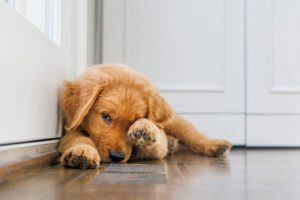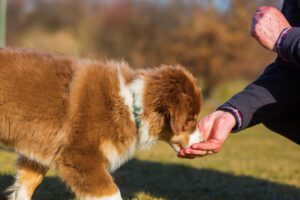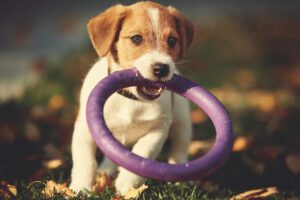Phonophobia, or fear of loud noises, is a common behavioral problem for dogs. In fact, it may affect anywhere between a quarter and half of the dog population! Whether you’re looking to raise a confident puppy or help an adult dog that has developed this fear, owners can take steps to reduce fear of noises in dogs. Here is how!
Start Young
As with most training, the younger that you can start to work with your puppy, the better. In fact, diligent breeders start in on noise desensitization from the day that puppies’ eyes and ears open. What your puppy is exposed to when they are young will have a major impact on the rest of their lives. Introduce your puppy to novel sounds can prevent them from developing a fear in the future.
Fear Periods

In addition to the puppy socialization period (most critical during the first 3-14 weeks of life), it is worth noting that puppies go through fear periods. The first period happens around 8-12 weeks old. In other words, this is the age when most puppies are going home. Puppies are also likely to experience a secondary fear period between 6-14 months. As an owner, it may be disconcerting that your puppy is suddenly wary of something that never bothered them before. With patience and positive reinforcement, you can overcome this obstacle as a team.
Signs of Noise Phobia
It’s easy to tell that your puppy has a fear of noise if they head for the hills every time someone sneezes too loudly. Other signs of anxiety may be more subtle. We recommend familiarizing yourself with dog body language. Here are some signs of stress or fear:

- Tucking tail under body
- “Whale eye” (dog’s eye whites are visible)
- Lip licking
- Ears pinned back
- Pacing
- Shaking or trembling
- Panting or drooling (not to be confused with panting after exercise or because of heat)
- Barking, whining, or howling
- Potty accidents
- Digging, scratching, chewing, or other destructive behaviors
- Becoming clingy with humans
- Hiding in an enclosed space
- Frantically trying to escape a situation
Counterconditioning
In past blogs, such as our blog on introducing your new puppy to your dog, we have described the process of gradually building a positive association. By exposing your puppy to the stressor and then giving your dog a positive experience at the same time, you can gradually reduce your puppy’s anxiety. This is called counterconditioning.

In this case, you will be producing a loud noise and pairing it with a positive experience. This can be a high-value treat, play, or both, depending on what your puppy finds the most motivating. If possible, try to use the actual noise that triggers your dog’s fear (e.g. turn on the blender or vacuum, pull up a youtube video of an ambulance siren or dogs barking). Start far away from the source of the noise or with the volume low and give your dog their treat. Repeat until the puppy no longer seems visibly stressed, then encourage your puppy to move closer to the source of the noise or turn up the volume.
Safety First!
Remember to never place your puppy or yourself in a dangerous situation. For instance, if you have decided to acclimate your puppy to fireworks by setting off firecrackers, make sure that your dog is leashed and always maintain a safe distance. (Also, check your local ordinances about the legality of purchasing fireworks.) Similarly, gun ranges or construction sites are a source of frequent, loud noises, but should only be utilized with serious caution. Listening to the noises from inside your car with your dog will have a similar benefit with much less safety risk.
Take Things at Your Dog’s Pace

Patience is crucial! Different dogs will progress at different rates. Factors such as age, breed, past experiences, and personality all will play a role. Keep working with your dog until they seem completely comfortable before increasing intensity. Do not try to force your dog to “face their fear” at any point. This can backfire and cause your dog to become more fearful than ever.
Consider a Noise Box
If your pup is timid and fearful, consider making them a Noise Box. Take an empty box and place a few clean plastic bottles or tin cans inside, then add some high value treats to the bottom of box. Your puppy will have to move around the objects in the box to reach the treats, causing noise. As your puppy grows more comfortable using the box, add more objects. Try spoons, crumpled newspaper, or anything else that will not hurt your dog as they snuffle around. This tool is a great tool to build your puppy’s confidence. Noise boxes should only be used with human supervision.
Keep Things Positive
Remain calm and cheerful while working with your puppy. Dogs are very sensitive to our moods, and will be able to pick up on if you become frustrated or stressed yourself. Never, ever use your dog’s fear as a punishment tool. Finally, regardless of how a session goes, always try to end on a positive note.
Refresh From Time to Time
While we are not advising constantly bombarding your puppy with loud noises, do remember to give your puppy a refresher from time to time. Try to do this in different areas of your home or outside. This reinforces for your puppy that whenever and wherever a loud noise crops up, they have nothing to fear.
We did all of this, so why is my dog still afraid of thunderstorms?

It’s frustrating if your puppy has progressed to the point where they can sniff curiously at your computer playing thunder sounds but still becomes a shaking ball of terror during a monsoon. Remember that certain experiences are multisensory. In the case of storms, fireworks, or some other triggers, they are not only experiencing loud noises. There are also flashes of light, different smells, and vibrations in the air that cannot be replicated through a recording. By laying this groundwork, your puppy will be more receptive to counterconditioning during the actual event. Try to work with your puppy during these events. With any luck, your dog will relax as they fall into this familiar routine.
Reach Out for Help
Still struggling? Consider reaching out to a professional trainer for a more intensive intervention. In severe cases, talk to your vet about possible medications to help alleviate your dog’s anxiety. Finally, remember that your Puppy Specialists at Animal Kingdom and Puppies ‘N Love are just a phone call away!




